The physical transformation of displaying male Greater Sage-Grouse would make a metamorphosing butterfly proud.
Note: Each of these images was taken approximately two weeks ago in Wayne County, Utah. All but the first image were taken on an active lek.
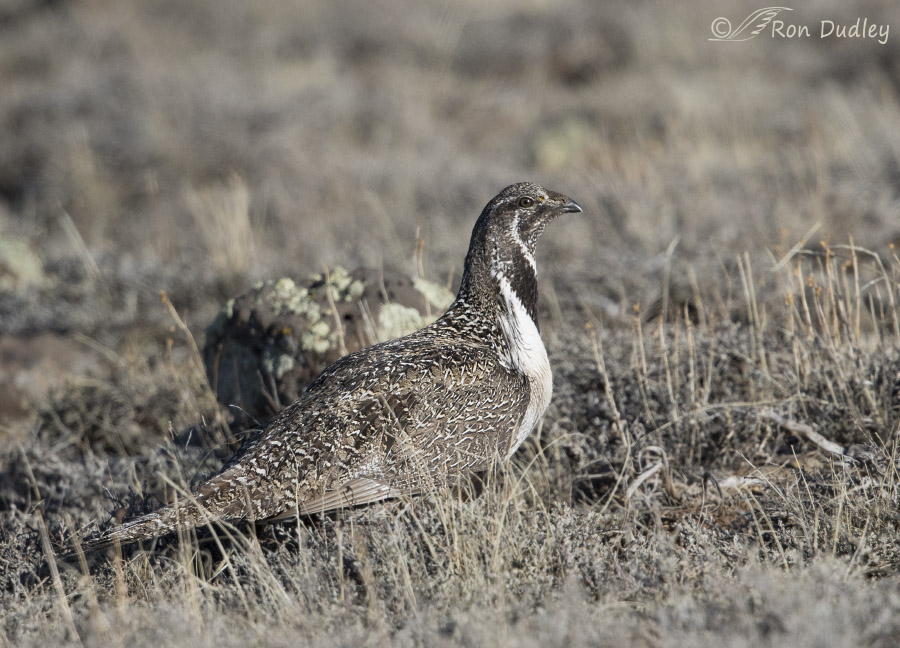
1/3200, f/6.3, ISO 500, Canon 7D, Canon EF500mm f/4L IS II USM +1.4 tc, not baited, set up or called in
This is what the adult male looks like during breeding season when it isn’t displaying. Note the black on chin and throat (absent in the female), extremely long tail and yellow fleshy comb above the eye (less conspicuous in female though this male’s comb can’t be seen well here).
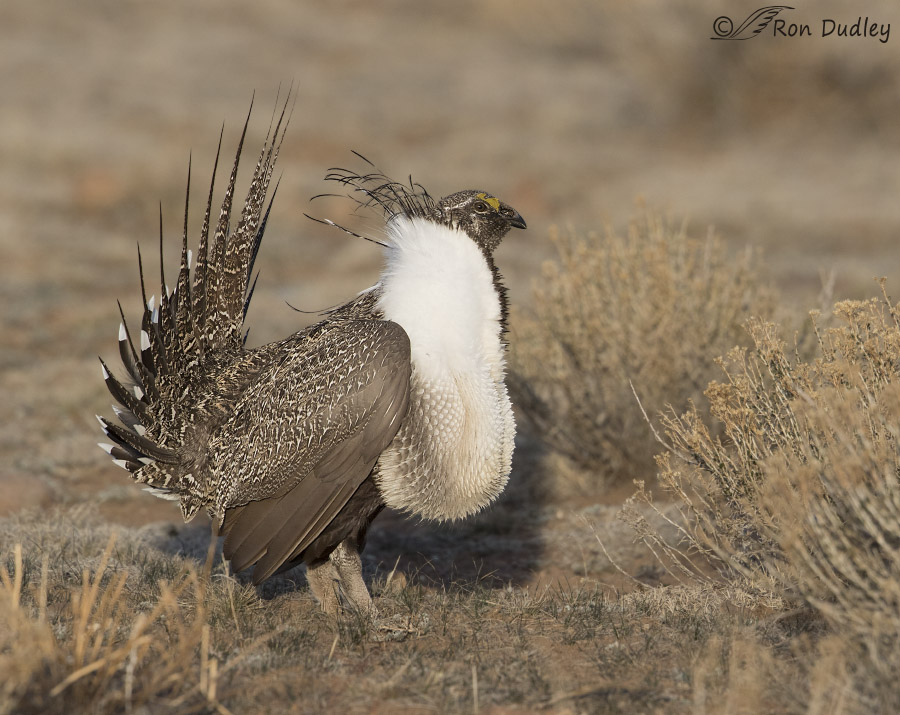
1/1250, f/7.1, ISO 800, Canon 7D, Canon EF500mm f/4L IS II USM +1.4 tc, not baited, set up or called in
But when the male is on the lek performing his strut display he almost looks like a different species. The tail becomes fanned and erect, the breast distended, yellow eye-combs erect and more obvious and long filoplume feathers arising from the back of the neck are exposed. He then inflates part of his esophagus contained in a muscular bag at the bottom of his neck
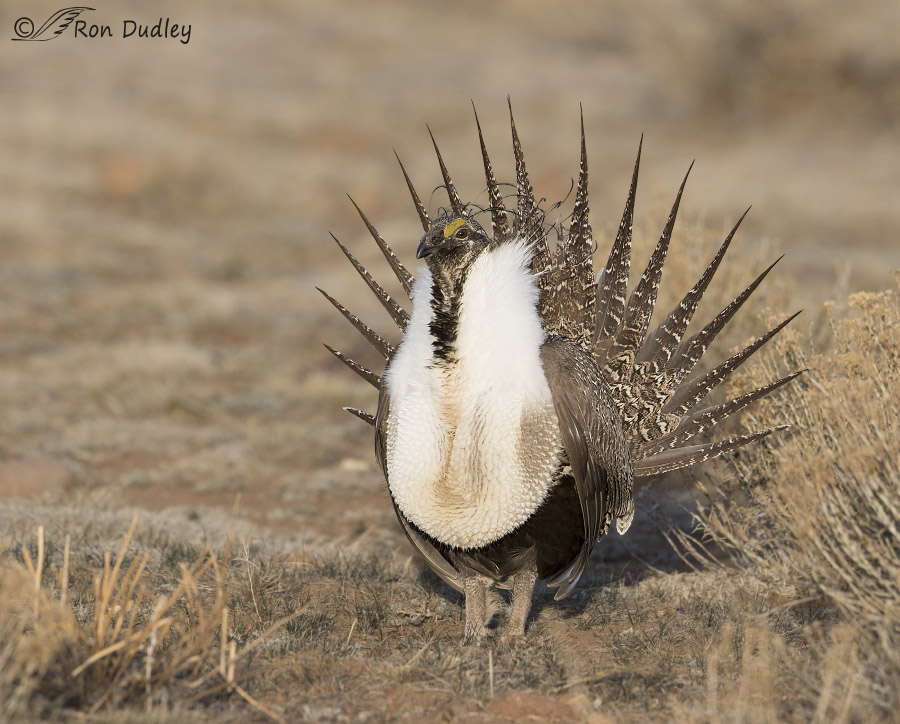
1/1250, f/7.1, ISO 800, Canon 7D, Canon EF500mm f/4L IS II USM +1.4 tc, not baited, set up or called in
Here’s a front view at about the same stage of the display as the previous image. There are two yellowish patches of bare skin (cervical apteria) on the lower throat and breast that at this point are still hidden but…
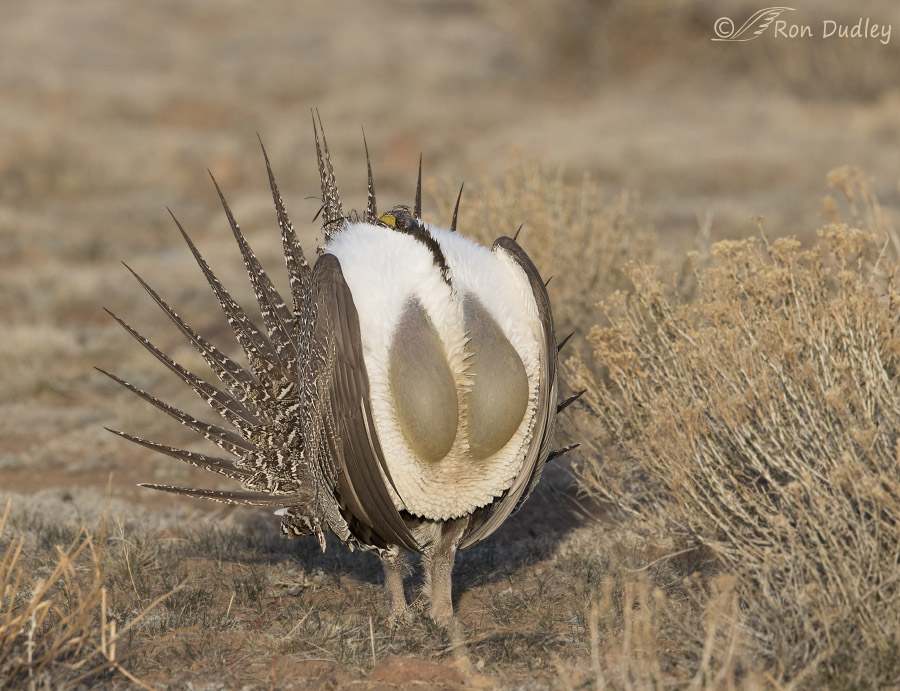
1/800, f/9, ISO 800, Canon 7D, Canon EF500mm f/4L IS II USM +1.4 tc, not baited, set up or called in
they soon become inflated and highly conspicuous. These air sacs bulge repeatedly as he heaves the esophageal expansion up and down during the display (all the time keeping his outreached wings stiffly at his sides). Sound production coincides with this expansion and deflation of the air sacs. The expanded air sacs provide a matronly look (IMO)…
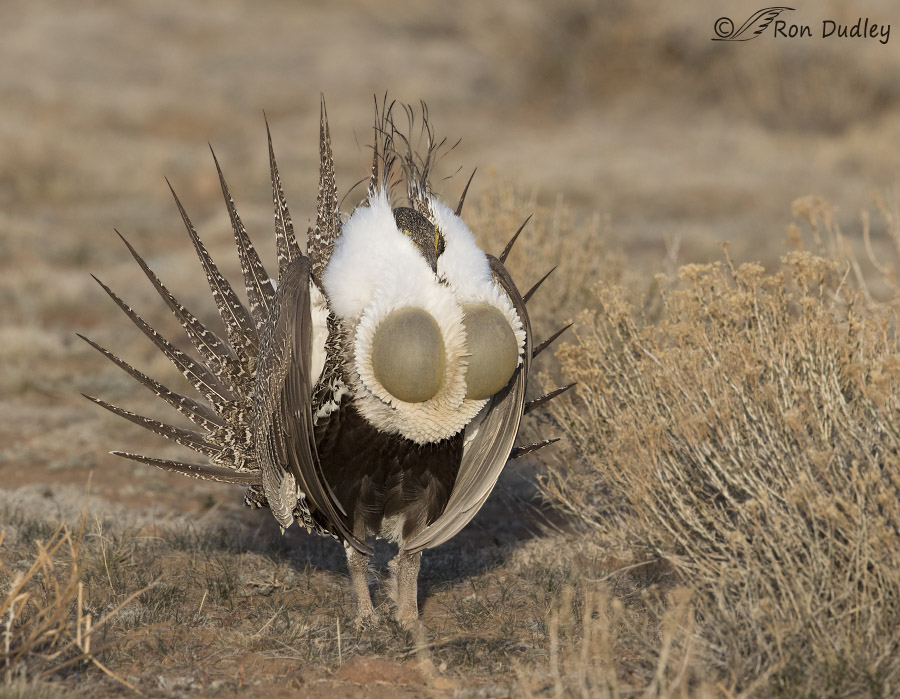
1/800, f/9, ISO 800, Canon 7D, Canon EF500mm f/4L IS II USM +1.4 tc, not baited, set up or called in
and if you click your shutter at just the right moment that look is exaggerated.
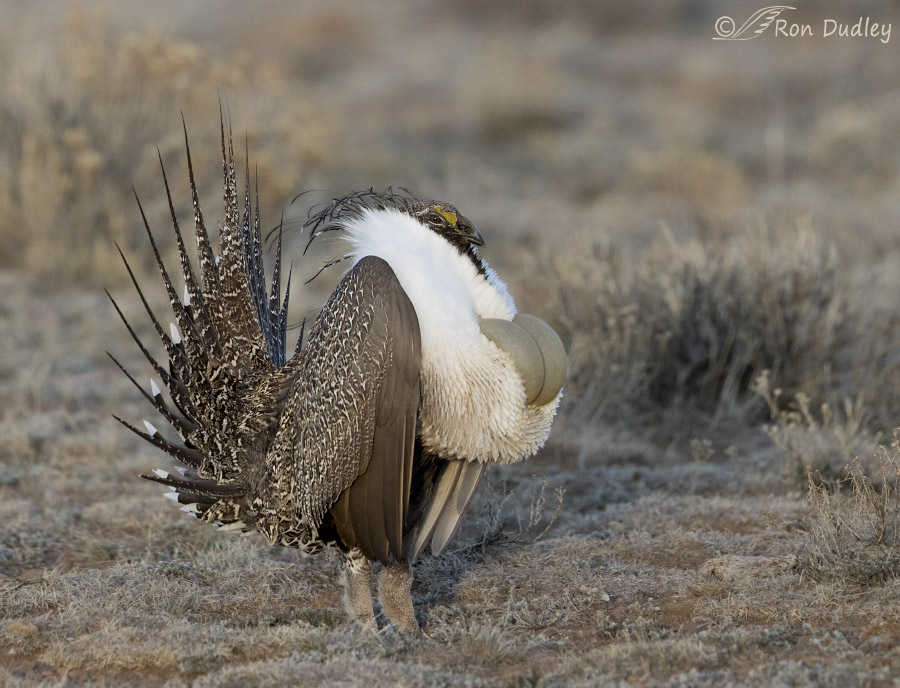
1/800, f/6.3, ISO 1600, Canon 7D, Canon EF500mm f/4L IS II USM +1.4 tc, not baited, set up or called in
A side view shows that the air sacs briefly resemble two inflated balloons giving the poor guy a distinctly bosomy appearance.
The sounds made during the display are both vocal and nonvocal. The nonvocal portion (a “plopping” sound called an air sac pop) is produced and amplified by the inflated air sacs. The entire sound array can be heard here.
Research shows that though there are typically many grouse of both sexes on the lek most of the females mate with the same one or two males. From BNA Online:
- “2 males obtained 74% of 174 copulations in Wyoming (Scott 1942), 54% of 103 copulations in Saskatchewan and Montana (Lumsden 1968), 86% of 42 copulations in Wyoming (Wiley 1973b), and 66% of 533 copulations in Montana (Hartzler and Jenni 1988). One male copulated 169 times in one season in Montana (Hartzler and Jenni 1988). Mating is brief, lasting only a few seconds, and males may mate with other females within 2 min and may mate >20 times in a morning”
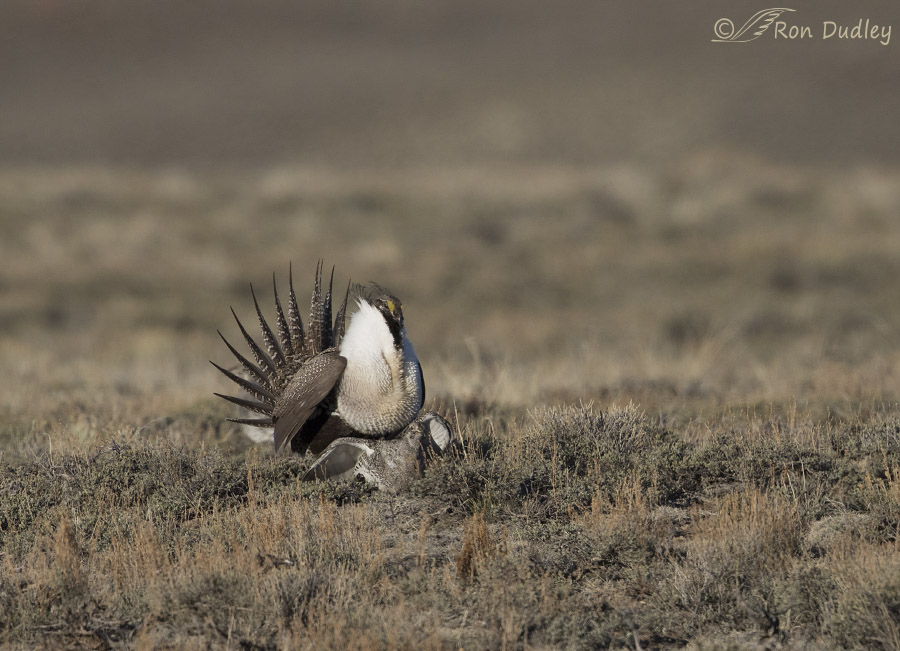
1/2500, f/7.1, ISO 500, Canon 7D, Canon EF500mm f/4L IS II USM +1.4 tc, not baited, set up or called in
And that’s exactly what I observed while watching these birds on the lek – the females seemed to be mating with only one or two of the males. The other males strutted their stuff but their efforts were apparently in vain. I never did get any decent photos of mating grouse, they were always either too far away (as they were here) or I was focused on other birds and missed the excitement.
Ron


Magnificent shots of a bird I’ve never seen! Sensational series Ron!
Charlotte
Thanks very much, Charlotte.
I think if one of us flashed like that, we’d be arrested!!!
Probably so, Patty – at least in many places.
Oh the transformative powers of love/lust.
An incredible series. And I can see where some people (and their surgeons) got the idea that a triple E cup size is attractive…
“Oh the transformative powers of love/lust.”
Exactly, EC!
My my my! Matronly and mating all in one post? 😀 Fun series! I really liked seeing the transformation.
Couldn’t help myself, Arwen. Thank you.
Wow! inspires me to try visiting a lek when it is not snowing so hard, as it was the only time I was fortunate enough to see a Sage Grouse lek. Could you tell if the birds the females were selecting were located in approximately the center of the lek? I read that the males competed for the central areas and the females usually selected the males in that region.
Dave, the birds were distributed unevenly over the lek so it was difficult to tell where the center was. They were actually in three main groups and I didn’t even know one of the groups was there for most of the time because they were hidden behind a small hill. So the short answer is no, I couldn’t tell if the females were selecting mating partners in the center.
What did you say to persuade that bird to do such a show? To me this is a great posing session.
What a sense of opportunity.
Very very interesting.
Didn’t have to say anything, Jorge, all I had to do was show up at the lek. And the posing session went on for several hours. I often had more birds up close than I could handle. Or photograph.
That big GUY, strutting his stuff, reminds me of some of the “physically ‘enhanced’ ” female humans you see strutting their “enhancements” around these days!!! You’re SURE that’s a male, right???
Pretty sure, Patty. Pretty sure…
Hi Ron,
Thanks as always for the great images and education. I have visited several leks over the years, but I have never observed copulation. I guess I have been distracted by that metamorphosing mambo (and COLD temperatures). Great documentation!
Cheers,
Dick
Dick, it was cold on this lek too – 21 degrees F. You can see frost on the ground in the second to the last photo. That may not sound all that cold but after several hours with the windows down and no heater we were chilled to the bone and shivering uncontrollably.
Matronly, huh?!? I had to laugh when I read that because that was my initial reaction, only in more common, slangy terms. This is a beautiful series. These are birds and behaviors that I doubt I’ll see in person, so it’s nice to have the opportunity to see them through your lens.
I’ll bet we both thought of the same “slangy terms”, Susan…
The saks look like two big eggs!! Maybe that’s appealing to the females. Amazing photos.
Maybe the “egg look” is inspiring to the females, Ellen. Who knows…:)
What an amazing series of images, Ron … and what a sense of humor Mother Nature has!!!!! Fabulous … and thanks for the link to the Cornel site, I love visiting there.
“what a sense of humor Mother Nature has!!!!!”
Agreed, Lois. I try to maintain a clinical objectivity while I’m watching them display with the air sacs inflated but they always make me smile and think of Dolly Parton with feathers…
An amazing series! Bird looks as if it becomes twice its original size and becomes a different species…wonder where it hides those super-long tail feathers and, again, am impressed and surprised by those feathery legs!!!
Patty, their legs and feet are fully feathered excluding their toes. I wonder “where it hides” those long filoplume feathers on the back of it’s neck. I’ve looked for them when they aren’t displaying but never could see them but they become so obvious (and silly looking) during the display.